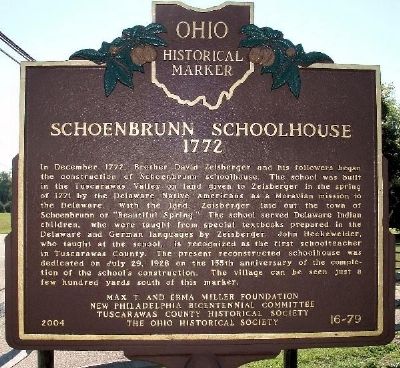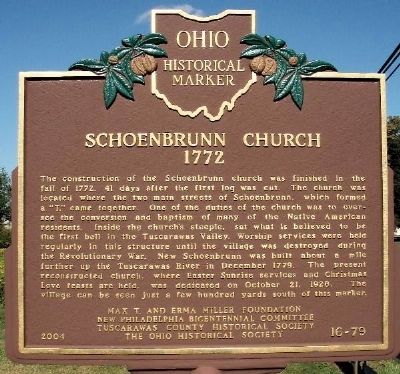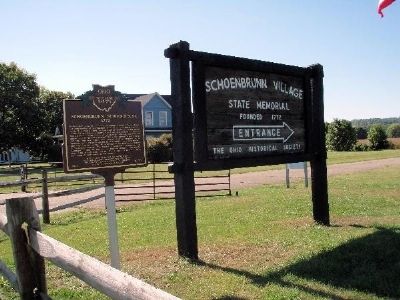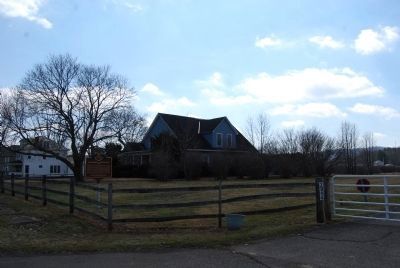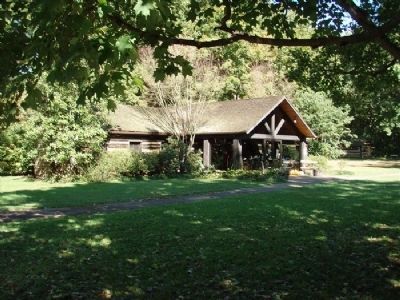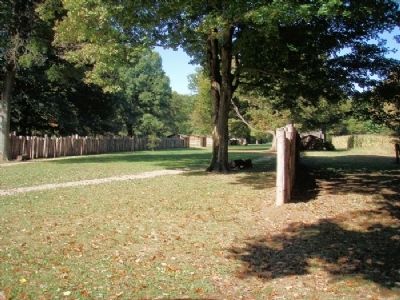New Philadelphia in Tuscarawas County, Ohio — The American Midwest (Great Lakes)
Schoenbrunn Schoolhouse 1772 / Schoenbrunn Church 1772
Schoenbrunn Schoolhouse 1772
In December 1772, Brother David Zeisberger and his followers began the construction of Schoenbrunn schoolhouse. The school was built in the Tuscarawas Valley on land given to Zeisberger in the spring of 1771 by the Delaware Native Americans as a Moravian mission to the Delaware. With the land, Zeisberger laid out the town of Schoenbrunn or "Beautiful Spring." The school served Delaware Indian children, who were taught from special textbooks prepared in the Delaware and German languages by Zeisberger. John Heckewelder, who taught at the school, is recognized as the first schoolteacher in Tuscarawas County. The present reconstructed schoolhouse was dedicated on July 29, 1928 on the 155th anniversary of the completion of the school's construction. The village can be seen just a few hundred yards south of this marker.
Schoenbrunn Church 1772
The construction of the Schoenbrunn church was finished in the fall of 1772, 41 days after the first log was cut. The church was located where the two main streets of Schoenbrunn, which formed a "T," came together. One of the duties of the church was to oversee the conversion and baptism of many of the Native American residents. Inside the church's steeple, sat what is believed to be the first bell in the Tuscarawas Valley. Worship services were held regularly in this structure until the village was destroyed during the Revolutionary War. New Schoenbrunn was built about a mile further up the Tuscarawas River in December 1779. The present reconstructed church, where Easter Sunrise services and Christmas Love feasts are held, was dedicated on October 21, 1928. The village can be seen just a few hundred yards south of this marker.
Erected 2004 by Max T. and Erma Miller Foundation - New Philadelphia Bicentennial Committee - Tuscararwas County Historical Society - The Ohio Historical Society. (Marker Number 16-79.)
Topics and series. This historical marker is listed in these topic lists: Churches & Religion • Education • Native Americans • Settlements & Settlers. In addition, it is included in the Ohio Historical Society / The Ohio History Connection series list. A significant historical month for this entry is July 1916.
Location. 40° 28.032′ N, 81° 24.808′ W. Marker is in New Philadelphia, Ohio, in Tuscarawas County. Marker is on East High Avenue (County Route 259), on the right when traveling south. Located at the site of the restored Schoenbrunn Village,. Touch for map. Marker is at or near this postal address: 1984 East High Avenue, New Philadelphia OH 44663, United States of America. Touch for directions.
Other nearby markers. At least 8 other markers are within 3 miles of this marker, measured as the crow flies. The New Schoenbrunn Mission / David Zeisberger, 1721–1808 (approx. 1˝ miles away); The Ohio-Erie Canal In Tuscarawas County / The Ohio-Erie Canal 1825-1913 (approx. 1.7 miles away); Look above the awning for the Landmarks of Tuscarawas County (approx. 2.2 miles away); Tuscarawas County Operation Desert Storm Memorial (approx. 2.3 miles away); Tuscarawas County Viet-nam Veterans Memorial (approx. 2.3 miles away); Revolutionary War Memorial (approx. 2.3 miles away); You Are Not Forgotten (approx. 2.3 miles away); Congressional Medal of Honor Recipients (approx. 2.3 miles away). Touch for a list and map of all markers in New Philadelphia.
More about this marker. This site is on the National Register of Historic Places.
Regarding Schoenbrunn Schoolhouse 1772 / Schoenbrunn Church 1772. When Rev. David Zeisberger traveled to the Northwest Territory and established his mission to the Delaware Indians in 1772, he perhaps didn't realize that his work would eventually expand to over 60 buildings and become the first settlement in what became the state of Ohio. Through the efforts of the mission the first civil code was drafted and the first school and church were built in the village laid out in the shape of a Christian cross.
It was partly the friendship that Zeisberger
struck up with Pennsylvanian John Knisley on one of his hunting trips that resulted in Knisley's return to establish and design the nearby town of New Philadelphia in 1804 which became the county seat of the newly formed Tuscarawas County. Charles H Knisely offers these interesting details on the "http://www.newphilaoh.com/" New Philadelphia web site:
John Knisely happened to choose the site of New Philadelphia as a result of his fondness for hunting. In the autumn of 1803, he with his son Samuel, went on a deer hunting trip into the Ohio Country. Crossing the Ohio River, just above where Steubenville is now located, they followed an Indian trail to the Moravian Mission Village of Schoenbrunn, which had been established in 1772 by David Zeisberger. John Knisely and his son, stayed at Schoenbrunn for a few days, and were very successful in hunting deer. John Knisely and David Zeisberger became good friends at this time, and this friendship lasted until Zeisberger's death in 1818.
John Knisely was greatly impressed by the natural resources, the beautiful plains, the fertile river bottomlands, and the fine stand of oak timber in the Tuscarawas River Valley. He also noticed that a big plateau in the bend of the river, with numerous smaller valleys centering there, would make a beautiful site for a town and perhaps, as he hoped, a great city. According to Zeisberger's
Diary, the son, Samuel Knisely, remained at the Schoenbrunn Mission during the winter of 1803-1804, while John Knisely returned home to Bedford County to begin his project to found his city.
On his return home, John Knisely sold his possessions for $16,000.00 and made preparations to move his family, consisting of his wife, six sons and four daughters. Early in the spring of 1804, he started on the trip west with several teams, loaded with articles that would be most needed, such as farm implements, seeds to start their first crops, and other necessary household items. John Knisely also persuaded 33 pioneers to accompany him. They formed the nucleus of the new town. In 1804, Ohio was almost a complete wilderness, with the exception of Marietta, Cincinnati, the Moravian Missions and a few other small clearings in Eastern Ohio.
On October 23, 1804, John Knisely met John Heckewelder at Gnadenhutten. Mr. Heckewelder, in addition to his missionary work, acted as agent for land proprietors in the East. In his capacity as land agent, he held the power of attorney for Godfrey Haga, a Philadelphia merchant who owned thousands of acres in this area. Under this power, John Heckewelder sold John Knisely a plot of 3,554 acres for the sum of $5,454.33 which embraces most of the present city of New Philadelphia, Ohio.
John Knisely, as a result of his meeting with both David Zeisberger and John Heckewelder, became a firm friend of the Moravian Missions. Zeisberger reveals in his diary, that during the War of 1812, the feelings of the early settlers were very much aroused against the Indians, including the Christian Indians. John Knisely stood by the missionaries and prevented any mob action that threatened the missions. He remained a loyal friend of the mission until 1818, when Zeisberger died and the last Moravian Mission Station at Goshen was abandoned.
Today the site is maintained as the http://www.stateparks.com/schoenbrunn_village.html Schoenbrunn Village State Memorial. This is a living history museum with many activities in the reconstructed village such as the annual http://www.schoenbrunnvillagefair.org/ Schoenbrunn Village Fair
The highlight is the powerful drama, written by Pulitzer prize-winning playwright Paul Green. Performed at the nearby Schoenbrunn Amphitheater, "It is an unforgettable experience that brings to life the Ohio frontier during the Revolutionary War. Performed in the same hills from which this story is born, Trumpet is a thrilling and passionate story of a peaceful people's influence on the war and the tragic events that encircled the founding of Ohio's first settlement, Schoenbrunn."
The site is CLOSED from November through May.
Related markers. Click here for a list of markers that are related to this marker.
Credits. This page was last revised on September 28, 2017. It was originally submitted on April 24, 2014, by Larry Wilson of Wareham, Massachusetts. This page has been viewed 654 times since then and 22 times this year. Photos: 1, 2, 3. submitted on April 24, 2014, by Larry Wilson of Wareham, Massachusetts. 4. submitted on March 16, 2015, by Mike Wintermantel of Pittsburgh, Pennsylvania. 5, 6. submitted on April 24, 2014, by Larry Wilson of Wareham, Massachusetts. • Bill Pfingsten was the editor who published this page.
